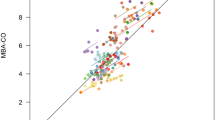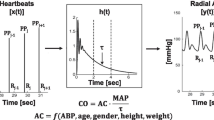Abstract
Objective
Cardiac output (CO) has traditionally been measured using invasive techniques, which involve an element of risk. Thus, a reliable less-invasive method for determining CO would be very valuable for research use. We tested whether simple analysis of the arterial pulse waveform, not requiring large-vessel catheterisation or expensive equipment, could provide an estimate of CO that is accurate enough for pharmacological studies.
Methods
We measured CO in 11 healthy male subjects who received low and high doses of dexmedetomidine (α2-adrenoceptor agonist), using pulse contour analysis, echocardiography and pulmonary thermodilution techniques.
Results
At baseline, these methods gave the following mean (SD) values of CO: 6.18 (1.59), 5.22 (1.35) and 7.03 (1.54) l/min, respectively. High-dose dexmedetomidine reduced CO to 4.50 (0.68), 3.65 (0.65) and 4.80 (0.89) l/min, corresponding to −25 (14) %, −28 (12) % and −30 (14) % reductions from baseline, respectively. The pulse contour method described these dexmedetomidine-induced changes in CO very similarly to the thermodilution and echocardiographic methods. The limits of agreement [bias (2SD)] were 0.55 (2.55) and −0.10 (2.04) l/min, respectively.
Conclusion
The minimally invasive pulse contour analysis technique might be suitable for pharmacological studies for the detection of major drug-induced reductions in CO.


Similar content being viewed by others
References
Conway J (1990) Clinical assessment of cardiac output. Eur Heart J 11:148–150
Boyd KD, Thomas SJ, Gold J, Boyd AD (1983) A prospective study of complications of pulmonary artery catheterizations in 500 consecutive patients. Chest 84:245–249
Horst HM, Obeid FN, Vij D, Bivins BA (1984) The risks of pulmonary arterial catheterization. Surg Gynecol Obstet 159:229–232
Hett DA, Jonas MM (2004) Non-invasive cardiac output monitoring. Intensive Crit Care Nurs 20:103–108
Botero M, Lobato EB (2001) Advances in noninvasive cardiac output monitoring: an update. J Cardiothorac Vasc Anesth 15:631–640
Wesseling KH, Jansen JR, Settels JJ, Schreuder JJ (1993) Computation of aortic flow from pressure in humans using a nonlinear, three-element model. J Appl Physiol 74:2566–2573
Wesseling KH, de Wit B, Weber JAP, Smith NT (1983) A simple device for the continuous measurement of cardiac output. Its model basis and experimental verification. Adv Cardiovasc Phys 5:16–52
Linton NW, Linton RA (2001) Estimation of changes in cardiac output from the arterial blood pressure waveform in the upper limb. Br J Anaesth 86:486–496
Hamilton TT, Huber LM, Jessen ME (2002) PulseCO: a less-invasive method to monitor cardiac output from arterial pressure after cardiac surgery. Ann Thorac Surg 74:S1408–S1412
Kuusela TA, Jartti TT, Tahvanainen KU, Kaila TJ (2004) Effects of terbutaline on peripheral vascular resistance and arterial compliance. J Cardiovasc Pharmacol 44:74–81
Ebert TJ, Hall JE, Barney JA, Uhrich TD, Colinco MD (2000) The effects of increasing plasma concentrations of dexmedetomidine in humans. Anesthesiology 93:382–394
Shafer SL, Siegel LC, Cooke JE, Scott JC (1988) Testing computer-controlled infusion pumps by simulation. Anesthesiology 68:261–266
Imholz BPM (1991) Noninvasive finger arterial pressure waveform registration: evaluation of Finapres and Portapres. Thesis, University of Amsterdam, Amsterdam
Stok WJ, Baisch F, Hillebrecht A, Schulz H, Meyer M, Karemaker JM (1993) Noninvasive cardiac output measurement by arterial pulse analysis compared with inert gas rebreathing. J Appl Physiol 74:2687–2693
Schmid ER, Schmidlin D, Tornic M, Seifert B (1999) Continuous thermodilution cardiac output: clinical validation against a reference technique of known accuracy. Intensive Care Med 25:166–172
Thrush D, Downs JB, Smith RA (1995) Continuous thermodilution cardiac output: agreement with Fick and bolus thermodilution methods. J Cardiothorac Vasc Anesth 9:399–404
Hillis GS, Bloomfield P (2005) Basic transthoracic echocardiography. Br Med J 7505:1432–1436
Mehta N, Iyawe VI, Cummin AR, Bayley S, Saunders KB, Bennett ED (1985) Validation of a Doppler technique for beat-to-beat measurement of cardiac output. Clin Sci (Lond) 69:377–382
Andersen UB, Moller S, Bendtsen F, Henriksen JH (2003) Cardiac output determined by echocardiography in patients with cirrhosis: comparison with the indicator dilution technique. Eur J Gastroenterol Hepatol 15:503–507
Estagnasie P, Djedaini K, Mier L, Coste F, Dreyfuss D (1997) Measurement of cardiac output by transesophageal echocardiography in mechanically ventilated patients. Comparison with thermodilution. Intensive Care Med 23:753–759
Chew MS, Poelaert J (2003) Accuracy and repeatability of pediatric cardiac output measurement using Doppler: 20-year review of the literature. Intensive Care Med 29:1889–1894
Bland JM, Altman DG (1986) Statistical methods for assessing agreement between two methods of clinical measurement. Lancet 1:307–310
Critchley LA, Critchley JA (1999) A meta-analysis of studies using bias and precision statistics to compare cardiac output measurement techniques. J Clin Monit Comput 15:85–91
Della Rocca G, Costa MG, Coccia C, Pompei L, Di Marco P, Vilardi V, Pietropaoli P (2003) Cardiac output monitoring: aortic transpulmonary thermodilution and pulse contour analysis agree with standard thermodilution methods in patients undergoing lung transplantation. Can J Anaesth 50:707–711
Bein B, Worthmann F, Tonner PH, Paris A, Steinfath M, Hedderich J, Scholz J (2004) Comparison of esophageal Doppler, pulse contour analysis, and real-time pulmonary artery thermodilution for the continuous measurement of cardiac output. J Cardiothorac Vasc Anesth 18:185–189
Rödig G, Prasser C, Keyl C, Liebold A, Hobbhahn J (1999) Continuous cardiac output measurement: pulse contour analysis vs thermodilution technique in cardiac surgical patients. Br J Anaesth 82:525–530
McLean AS, Needham A, Stewart D, Parkin R (1997) Estimation of cardiac output by noninvasive echocardiographic techniques in the critically ill subject. Anaesth Intensive Care 25:250–254
Luchette FA, Porembka D, Davis K Jr, Branson RD, James L, Hurst JM, Johannigman JA, Campbell RS (2000) Effects of body temperature on accuracy of continuous cardiac output measurements. J Invest Surg 13:147–152
Darovic GO (ed) (2002) Hemodynamic monitoring: invasive and noninvasive clinical application, 3rd edn. Saunders, Philadelphia, USA
Medin DL, Brown DT, Wesley R, Cunnion RE, Ognibene FP (1998) Validation of continuous thermodilution cardiac output in critically ill patients with analysis of systematic errors. J Crit Care 13:184–189
Nichols WW, O’Rourke MF (1998) Measuring principles of arterial waves. In: McDonald’s blood flow in arteries: theoretical, experimental and clinical applications. Oxford University Press, New York, pp 114–153
Gardner RM (1981) Direct blood pressure measurement-dynamic response requirements. Anesthesiology 54:227–236
Heimann PA, Murray WB (1993) Construction and use of catheter-manometer systems. J Clin Monit 9:45–53
Acknowledgements
This study was financially supported by grants of EVO from the Turku University Hospital, Finland, the Juselius Foundation, and the Finnish Heart Foundation.
Author information
Authors and Affiliations
Corresponding author
Rights and permissions
About this article
Cite this article
Penttilä, J., Snapir, A., Kentala, E. et al. Estimation of cardiac output in a pharmacological trial using a simple method based on arterial blood pressure signal waveform: a comparison with pulmonary thermodilution and echocardiographic methods. Eur J Clin Pharmacol 62, 401–407 (2006). https://doi.org/10.1007/s00228-006-0115-1
Received:
Accepted:
Published:
Issue Date:
DOI: https://doi.org/10.1007/s00228-006-0115-1




